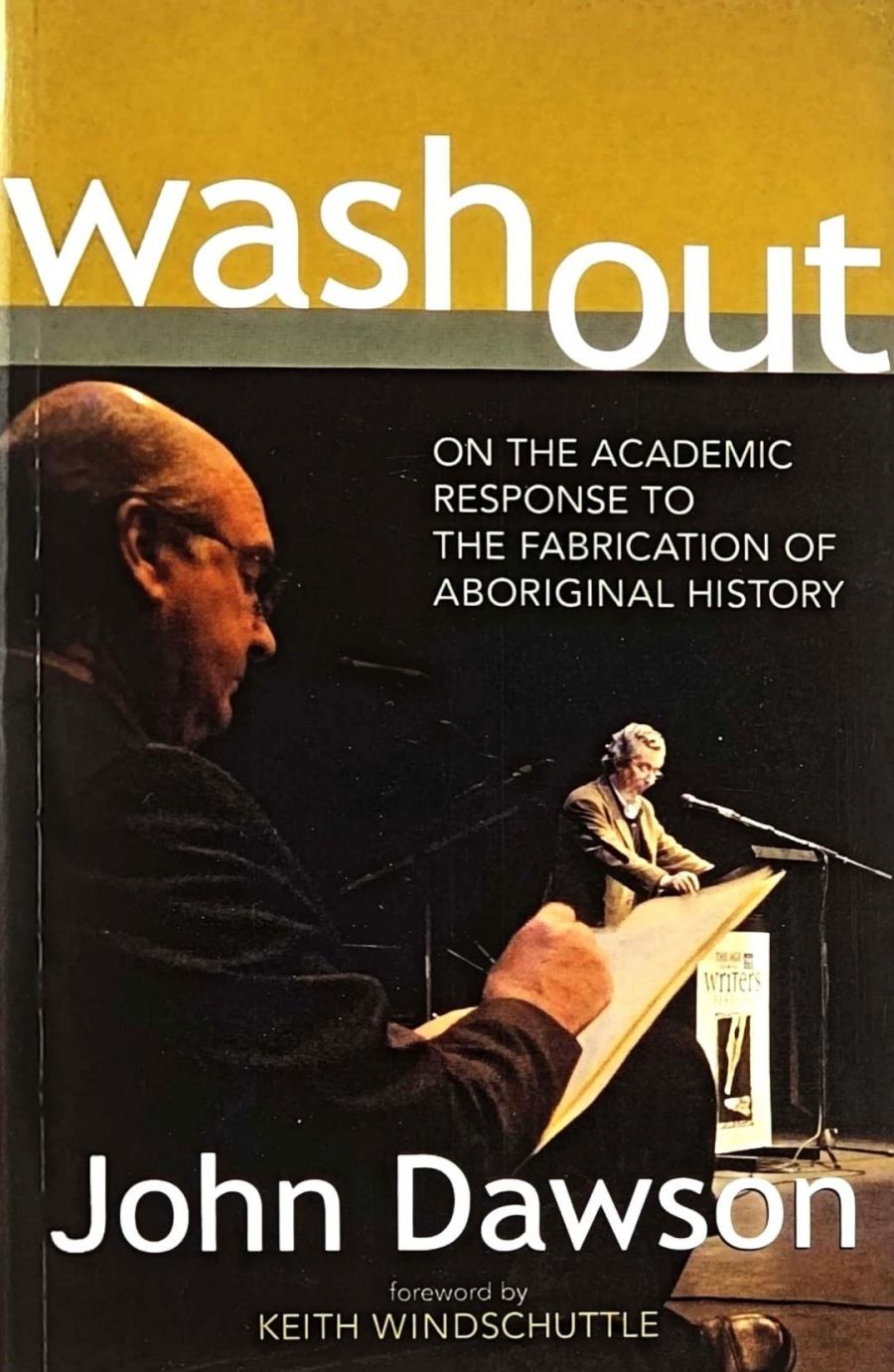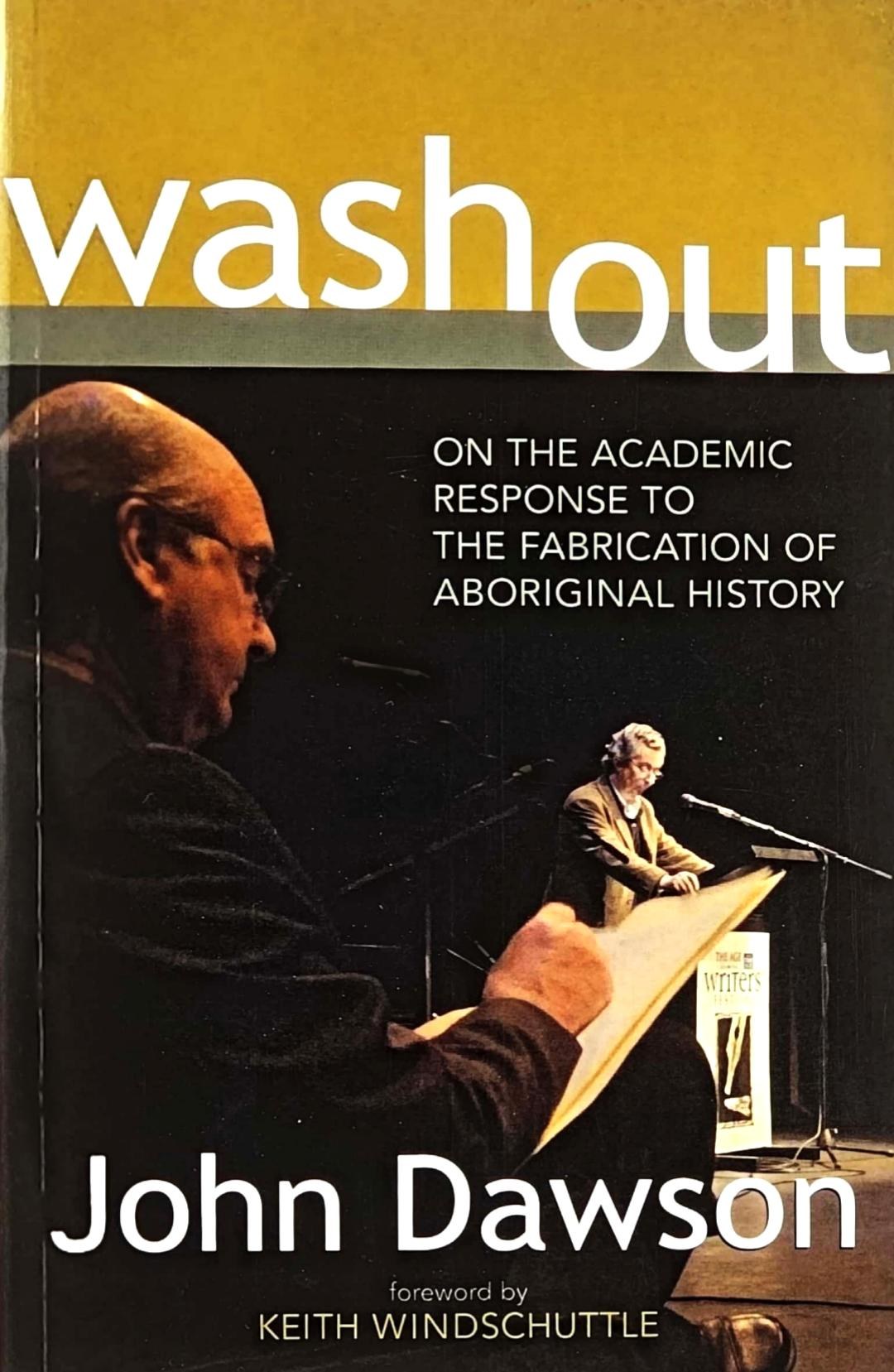
- Free Article: No
- Contents Category: History
- Review Article: Yes
- Article Title: Low and behold!
- Online Only: No
- Custom Highlight Text:
In 2003, I edited a book called Whitewash, a critique of Keith Windschuttle’s revisionist account of the destruction of the Tasmanian Aborigines, The Fabrication of Aboriginal History (2002). Even before Whitewash was published, Windschuttle told a journalist at The Australian, D.D. McNicoll, that he was preparing a book-length reply. Nothing came of this promise. Rather than answer his critics directly, what Windschuttle seems eventually to have decided to do was to finance, through the Press he owns, Macleay, the publication of John Dawson’s Washout. By its publication, Windschuttle hopes, presumably, to have saved face.
- Book 1 Title: Washout
- Book 1 Subtitle: On the academic response to the fabrication of Aboriginal history
- Book 1 Biblio: Macleay Press, $34.95 pb, 260 pp
- Book 1 Cover Small (400 x 600):

- Book 1 Cover (800 x 1200):

Dawson is a curious choice for this task. He is not an historian. Even as an amateur, he does not appear to have read widely (or indeed at all) in imperial, Australian, Tasmanian or Aboriginal history. His book, he admits, ‘makes no pretence’ to scholarship. This is one of the only claims in Washout with which I heartily agree.
The conceit at the centre of Dawson’s book is the idea that it does not require a scholar, or even a person acquainted with the relevant scholarship, to determine the relative merits of Fabrication and Whitewash. A simple comparison of the arguments will suffice. Unfortunately, even for that job, Dawson is singularly ill equipped. In part, this is because he is a partisan who came to Whitewash with his mind already closed. More deeply, it is because he has an almost uncanny ability to grasp any stick placed in front of him by the wrong end.
In their elegant essay in Whitewash, Martin Krygier and Robert van Krieken, for example, call the title of Windschuttle’s book ‘terrific’. Dawson thinks this is ‘faint praise to remind us that they are not polemicists’. He is genuinely unaware of the joke. Or again: Dawson is completely blind to the reason why critics of Windschuttle object to his description of the Tasmanian Aborigines as the ‘most primitive’ people on Earth. As he informs us, ‘if it were wrong, it would be a very simple matter to prove, because all they have to do is produce a more primitive society’.
Because he is so heroically unperceptive, one is obliged to assume that Dawson is not pretending when he fails, time and again, to identify clear-sightedly the core of the criticisms levelled at Windschuttle by Whitewash authors and the lethal damage they have done to his book. Let me illustrate.
In Fabrication, Windschuttle argues rather preposterously that the intensity of black–white conflict in the 1820s had nothing to do with the fact that this was the decade in which British settlers flocked to Tasmania and rapidly occupied the fertile central plain on which the Aboriginal economy relied. He claims instead that the Aborigines killed the settlers simply because they took pleasure in murder and coveted the settlers’ goods.
In his brilliant essay in Whitewash, James Boyce demolishes Windschuttle’s case. Boyce shows that, because Windschuttle is almost entirely unacquainted with the history of early Tasmania, he does not understand the difference between formal ownership and occupancy of land. His belief that only three per cent of Tasmania was occupied by the mid-1820s is a gross distortion of reality. Boyce also shows the complete falsity of Windschuttle’s fantasy that the British settlers ceased their hunting in 1811. In fact, during the 1820s, they continued on a veritable hunting spree for the game on which Aboriginal survival relied. In addition, he makes a very telling logical point. If Aborigines attacked British settlers, as Windschuttle claims, simply because they could, why did the attacks come not in the early days of settlement, when British society was at its most vulnerable, but rather, in the 1820s, when settlement was far denser and the settlers much better able to protect themselves?
Dawson seems incapable of seeing the power of Boyce’s critique. For him, Boyce’s demonstrations of Windschuttle’s errors over land occupancy and hunting in the 1820s are trivial, a mere ‘tinkering around the edges’. He genuinely does not understand how Boyce’s point about the relative peacefulness of early settlement fundamentally undermines Windschuttle’s disgusting and unsubstantiated case about the criminal rather than the patriotic essence of Aboriginal action in Tasmania.
Dawson is similarly blind on the question at the centre of Windschuttle’s book: the Aboriginal death toll. In Fabrication, Windschuttle argues that the number of Aborigines killed by British settlers can be more or less precisely known. The impossibility of this claim is obvious. Those who killed Aborigines, before the introduction of martial law, had very good reason not to report their action to the authorities in Hobart, who were trying to prevent the murder of Aborigines at settlers’ hands. Moreover, as Henry Reynolds points out in his chapter in Whitewash, when Aborigines were wounded in skirmishes with settlers, a considerable number were certain to die later and unobserved. For both these reasons, no precise death toll will ever be known. Dawson never really answers arguments of this kind. He concedes that Windschuttle should perhaps have added the words ‘that we know of’ to his ludicrous claim that ‘the British were responsible for the death of 118 indigenous inhabitants’, without seeing that his suggested addition would not ‘complete’ but demolish Windschuttle’s entire case.
Dawson is similarly insouciant about the weakness at the heart of Windschuttle’s argument about the relative importance of killing and disease in the destruction of almost the entire Aboriginal population by the 1830s. According to the method adopted by Windschuttle – which Dirk Moses in Whitewash calls ‘crazed positivism’ – unless there are documentary records of killings, the killings did not take place. Windschuttle believes that disease was the most important cause of the decline in the Aboriginal population. Yet in the case of death by disease, as Boyce points out, the documentary record prior to the transportation to Flinders Island is extremely thin. On this matter, Windschuttle wants to have it both ways. Once again, Dawson fails even to notice the strength of the argument, let alone to provide a convincing reply.
Washout has only two big themes. The first is genocide. Dawson praises Windschuttle for undermining the genocide claims of the so-called ‘orthodox school’ of historians. Yet his discussion of this issue is an extraordinary empirical and conceptual mess. Dawson, firstly, does not understand that the idea of British imperial responsibility for the extermination of the Tasmanian Aborigines (called, after the 1940s, genocide) has, rightly or wrongly, been a common understanding of civilised Western opinion since the middle of the nineteenth century. It is not the work of any orthodox school of Australian historians, past or present. Indeed, the case can be put more strongly than this. In Washout, the orthodox school is almost entirely composed of Henry Reynolds and Lyndall Ryan. In his An Indelible Stain (2001), Reynolds questions the use of the conventional idea of genocide – state policy aiming at the deliberate destruction of a race or nation – in the case of colonial Tasmania. In her The Aboriginal Tasmanians (1981), Ryan uses the word genocide only once and then in the sense of cultural genocide in a discussion of the policy of assimilation. Dawson is altogether undeterred by the absence in both cases of what he regards as incriminating evidence. Reynolds’s argument is distorted very dishonestly; while Ryan’s single sentence is quoted, out of context and obsessively, on six or seven occasions at least.
Washout’s second big theme is postmodernism and the wickedness of those historians who preach cultural relativism and who, unlike Windschuttle and Dawson, supposedly do not understand that objective truth exists. The problem here is not only that Dawson’s discussion is hopelessly crude; it is also that it is difficult to imagine a target less appropriate than Whitewash for Dawson’s ignorant and bilious anti-postmodernist rant. Does Dawson really believe that Reynolds or Cassandra Pybus or, for that matter, Robert Manne are postmodernists? With the exception of Greg Lehman, the authors assembled in Whitewash are completely, almost stubbornly, traditional. Dawson, at one point, effectively accuses me of manipulating for my own sinister purposes a statement made by the Aboriginal woman Peggy Patrick. Being a champion of objective truth is not usually understood as providing a licence to lie.
As Washout reaches its climax, Dawson devotes several unwittingly comical pages to the imagined errors in formal logic found in Whitewash – argumentum ad hominem, argumentum ad miseracordiam, petitio principii (thrice). The effect is not improved by the fact that even the habit of proofreading seems to have been abandoned by now. On two occasions we need a ‘broarder’ context; twice we are regaled with the phrase ‘low and behold!’; Mark Finnane makes two appearances as the author of the essay by Ian McFarlane; Shayne Breen becomes Shane; we learn of the declaration of ‘marshall law’; we learn of the ‘souring’ Aboriginal death rate; the early explorer is called ‘Able Tasman’; the denialist historian David Irving is not only accused, perhaps for the first time in his career, of the sin of postmodernism but is also transmogrified into ‘David Irvine’.
By now Dawson seems too excited to care. In his final pages, he arrives at a condition that has always threatened – pure ideological self-intoxication. Western civilisation, we are told, now faces a great crisis. The external enemy is the Islamist terrorist. The internal enemy is the postmodernist traitor, who offers succour to the terrorist and contributes to books such as Whitewash. ‘At a time when medieval mystics are hijacking the modern world’s airliners and turning them against its heart,’ Dawson tells us, ‘these Pentium primitivists are hijacking its institutions and turning them against its mind.’
Given the violence of its opinions, Washout might actually be a dangerous book were it not so foolish and fanatical.


Comments powered by CComment